An Optimized Methodology for a Hybrid Photo-Voltaic and Energy Storage System Connected to a Low-Voltage Grid
Abstract
1. Introduction
2. Materials and Methods
2.1. PV Data and Consumer Load Data
2.2. Economy 7 Tariff
3. Proposed Methodology
4. Results and Discussion
4.1. Case 1 (Only Grid)
4.2. Case 2 (Grid and Solar PV System)
4.3. Case 3 (Grid, Solar PV System, and BSS)
4.4. Case 4 (Grid, PV, and Utilization of BSS during the Peak Hours Only)
4.5. Case 5 (Proposed Strategy)
5. Conclusions
Author Contributions
Funding
Conflicts of Interest
References
- The Core Writing Team; Pachauri, R.K.; Meyer, L. The Intergovernmental Panel on Climate Change, Climate Change 2014-Synthesis Report; IPCC: Geneva, Switzerland, 2014. [Google Scholar]
- Available online: https://ec.europa.eu/jrc/en/news/global-co2-emissions-fossil-fuels-and-industrial-processes-stall (accessed on 2 November 2018).
- Houghton, D. Global Warming: The Complete Briefing; Cambridge University Press: Cambridge, UK, 1997. [Google Scholar]
- Peet, J. Energy and the Ecological Economics of Sustainability; Island Press: Washington, DC, USA, 1992. [Google Scholar]
- Andres, R.J.; Gregg, J.S.; Losey, L.; Marland, G.; Boden, T.A.J.T.B.C.; Meteorology, P. Monthly, global emissions of carbon dioxide from fossil fuel consumption. Tellus B Chem. Phys. Meteorol. 2011, 63, 309–327. [Google Scholar] [CrossRef]
- Alexander, L.V.; Allen, S.K.; Bindoff, N.L.; Breon, F.-M.; Church, J.A.; Cubasch, U.; Emori, S.; Forster, P.; Friedlingstein, P.; Gillett, N. Summary for Policymakers; Cambridge University Press: Cambridge, UK, 2013. [Google Scholar]
- Turner, J.A. A realizable renewable energy future. Science 1999, 285, 687–689. [Google Scholar] [CrossRef] [PubMed]
- Fraunhofer ISE. Photovoltaics Report; Fraunhofer ISE: Freiburg, Germany, 2014. [Google Scholar]
- Shah, A.; Torres, P.; Tscharner, R.; Wyrsch, N.; Keppner, H. Photovoltaic technology: The case for thin-film solar cells. Science 1999, 285, 692–698. [Google Scholar] [CrossRef] [PubMed]
- Mobil, E. The Outlook for Energy: A View to 2040; Exxon Mobil: Irving, TX, USA, 2013. [Google Scholar]
- REN21. Renewable Energy Policy Network for the 21st Century Renewables 2017 Global Status Report; REN21 Secretariat: Paris, France, 2017; pp. 1–302. [Google Scholar]
- Stoppato, A.J.E. Life cycle assessment of photovoltaic electricity generation. Energy 2008, 33, 224–232. [Google Scholar] [CrossRef]
- Aulich, H.A.; Schulze, F.W. Crystalline silicon feedstock for solar cells. Prog. Photovolt. Res. Appl. 2002, 10, 141–147. [Google Scholar] [CrossRef]
- Phylipsen, G.J.M.; Alsema, E.A. Environmental Life-Cycle Assessment of Multicrystalline Silicon Solar Cell Modules; Department of Science, Technology and Society, Utrecht University Utrecht: Utrecht, The Netherlands, 1995. [Google Scholar]
- Cherrington, R.; Goodship, V.; Longfield, A.; Kirwan, K. The feed-in tariff in the UK: A case study focus on domestic photovoltaic systems. Renew. Energy 2013, 50, 421–426. [Google Scholar] [CrossRef]
- Pyrgou, A.; Kylili, A.; Fokaides, P.A. The future of the Feed-in Tariff (FiT) scheme in Europe: The case of photovoltaics. Energy Policy 2016, 95, 94–102. [Google Scholar] [CrossRef]
- Department of Energy and Climate Change (DECC). Microgeneration Strategy; Technical Report; DECC: London, UK, 2011.
- European Photovoltaic Industry Association (EPIA). Global Market Outlook for Photovoltaics until 2014; EPIA: Brussels, Belgium, 2012. [Google Scholar]
- Nge, C.L.; Ranaweera, I.U.; Midtgård, O.M.; Norum, L. A real-time energy management system for smart grid integrated photovoltaic generation with battery storage. Renew. Energy 2019, 130, 774–785. [Google Scholar] [CrossRef]
- Masters, C.L. Voltage rise: The big issue when connecting embedded generation to long 11 kV overhead lines. Power Eng. J. 2002, 16, 5–12. [Google Scholar] [CrossRef]
- Ueda, Y.; Kurokawa, K.; Tanabe, T.; Kitamura, K.; Sugihara, H. Analysis results of output power loss due to the grid voltage rise in grid-connected photovoltaic power generation systems. IEEE Trans. Ind. Electron. 2008, 55, 2744–2751. [Google Scholar] [CrossRef]
- Alet, P.J.; Baccaro, F.; De Felice, M.; Efthymiou, V.; Mayr, C.; Graditi, G.; Juel, M.; Moser, D.; Petitta, M.; Tselepis, S.; et al. Quantification, challenges and outlook of PV integration in the power system: A review by the European PV technology platform. In Proceedings of the EU PVSEC, Hamborg, Germany, 14–18 September 2015. [Google Scholar]
- Karakaya, E.; Hidalgo, A.; Nuur, C.J.R.; Reviews, S.E. Motivators for adoption of photovoltaic systems at grid parity: A case study from Southern Germany. Renew. Sustain. Energy Rev. 2015, 43, 1090–1098. [Google Scholar] [CrossRef]
- Zsiborács, H.; Baranyai, N.H.; Vincze, A.; Háber, I.; Pintér, G.J.E. Economic and Technical Aspects of Flexible Storage Photovoltaic Systems in Europe. Energies 2018, 11, 1445. [Google Scholar] [CrossRef]
- Hesse, H.; Schimpe, M.; Kucevic, D.; Jossen, A.J.E. Lithium-ion battery storage for the grid—A review of stationary battery storage system design tailored for applications in modern power grids. Energies 2017, 10, 2107. [Google Scholar] [CrossRef]
- Umair Ali, M.; Hussain Nengroo, S.; Adil Khan, M.; Zeb, K.; Ahmad Kamran, M.; Kim, H.J. A real-time simulink interfaced fast-charging methodology of lithium-ion batteries under temperature feedback with fuzzy logic control. Energies 2018, 11, 1122. [Google Scholar] [CrossRef]
- Ali, M.; Kamran, M.; Kumar, P.; Nengroo, S.; Khan, M.; Hussain, A.; Kim, H.J. An Online Data-Driven Model Identification and Adaptive State of Charge Estimation Approach for Lithium-ion-Batteries Using the Lagrange Multiplier Method. Energies 2018, 11, 2940. [Google Scholar] [CrossRef]
- Ralon, P.; Taylor, M.; Ilas, A.; Diaz-Bone, H.; Kairies, K. Electricity Storage and Renewables: Costs and Markets to 2030; IRENA: Abu Dhabi, United Arab Emirates, 2017. [Google Scholar]
- Nottrott, A.; Kleissl, J.; Washom, B. Energy dispatch schedule optimization and cost benefit analysis for grid-connected, photovoltaic-battery storage systems. Renew. Energy 2013, 55, 230–240. [Google Scholar] [CrossRef]
- Balcombe, P.; Rigby, D.; Azapagic, A. Energy self-sufficiency, grid demand variability and consumer costs: Integrating solar PV, Stirling engine CHP and battery storage. Appl. Energy 2015, 155, 393–408. [Google Scholar] [CrossRef]
- Stenzel, P.; Linssen, J.; Fleer, J. Impact of different load profiles on cost optimal system designs for battery supported PV systems. Energy Procedia 2015, 75, 1862–1868. [Google Scholar] [CrossRef]
- Gährs, S.; Mehler, K.; Bost, M.; Hirschl, B. Acceptance of Ancillary Services and Willingness to Invest in PV-storage-systems. Energy Procedia 2015, 73, 29–36. [Google Scholar] [CrossRef]
- Bortolini, M.; Gamberi, M.; Graziani, A. Technical and economic design of photovoltaic and battery energy storage system. Energy Convers. Manag. 2014, 86, 81–92. [Google Scholar] [CrossRef]
- Ratnam, E.L.; Weller, S.R.; Kellett, C.M. An optimization-based approach to scheduling residential battery storage with solar PV: Assessing customer benefit. Renew. Energy 2015, 75, 123–134. [Google Scholar] [CrossRef]
- Linssen, J.; Stenzel, P.; Fleer, J. Techno-economic analysis of photovoltaic battery systems and the influence of different consumer load profiles. Appl. Energy 2017, 185, 2019–2025. [Google Scholar] [CrossRef]
- Hassan, A.S.; Cipcigan, L.; Jenkins, N. Optimal battery storage operation for PV systems with tariff incentives. Appl. Energy 2017, 203, 422–441. [Google Scholar] [CrossRef]
- Brusco, G.; Burgio, A.; Menniti, D.; Pinnarelli, A.; Sorrentino, N. The economic viability of a feed-in tariff scheme that solely rewards self-consumption to promote the use of integrated photovoltaic battery systems. Appl. Energy 2016, 183, 1075–1085. [Google Scholar] [CrossRef]
- Parra, D.; Patel, M.K. Effect of tariffs on the performance and economic benefits of PV-coupled battery systems. Appl. Energy 2016, 164, 175–187. [Google Scholar] [CrossRef]
- Subramani, G.; Ramachandaramurthy, V.K.; Padmanaban, S.; Mihet-Popa, L.; Blaabjerg, F.; Guerrero, J.M. Grid-tied photovoltaic and battery storage systems with Malaysian electricity tariff—A review on maximum demand shaving. Energies 2017, 10, 1884. [Google Scholar] [CrossRef]
- Nengroo, S.; Kamran, M.; Ali, M.; Kim, D.H.; Kim, M.S.; Hussain, A.; Kim, H. Dual battery storage system: An optimized strategy for the utilization of renewable photovoltaic energy in the United Kingdom. Electronics 2018, 7, 177. [Google Scholar] [CrossRef]
- Singh, R.; Bansal, R.C.; Singh, A.R. Optimization of an isolated photo-voltaic generating unit with battery energy storage system using electric system cascade analysis. Electr. Power Syst. Res. 2018, 164, 188–200. [Google Scholar] [CrossRef]
- Koutroulis, E.; Kolokotsa, D.; Potirakis, A.; Kalaitzakis, K. Methodology for optimal sizing of stand-alone photovoltaic/wind-generator systems using genetic algorithms. Sol. Energy 2006, 80, 1072–1088. [Google Scholar] [CrossRef]
- Kaldellis, J.K.; Zafirakis, D. Optimum sizing of stand-alone wind-photovoltaic hybrid systems for representative wind and solar potential cases of the Greek territory. J. Wind Eng. Ind. Aerodyn. 2012, 107, 169–178. [Google Scholar] [CrossRef]
- Luna-Rubio, R.; Trejo-Perea, M.; Vargas-Vázquez, D.; Ríos-Moreno, G.J. Optimal sizing of renewable hybrids energy systems: A review of methodologies. Sol. Energy 2012, 86, 1077–1088. [Google Scholar] [CrossRef]
- Pintér, G.; Baranyai, N.H.; Wiliams, A.; Zsiborács, H. Study of Photovoltaics and LED Energy Efficiency: Case Study in Hungary. Energies 2018, 11, 790. [Google Scholar] [CrossRef]
- Available online: http://www.solar.sheffield.ac.uk/ (accessed on 27 October 2015).
- Nistor, S.; Wu, J.; Sooriyabandara, M.; Ekanayake, J. Capability of smart appliances to provide reserve services. Appl. Energy 2015, 138, 590–597. [Google Scholar] [CrossRef]
- Available online: https://www.elexon.co.uk/reference/technical-operations/profiling/ (accessed on 4 April 2018).
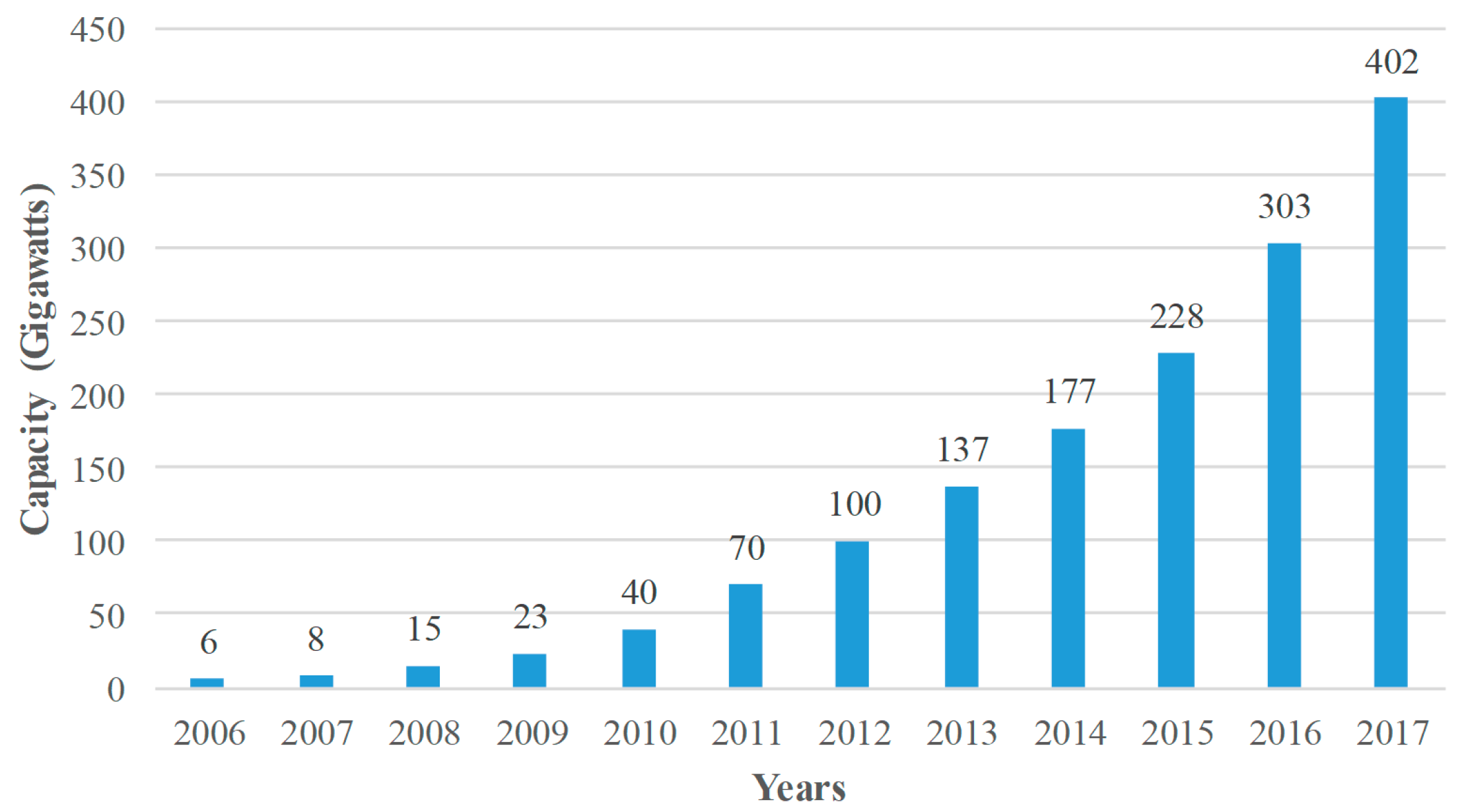
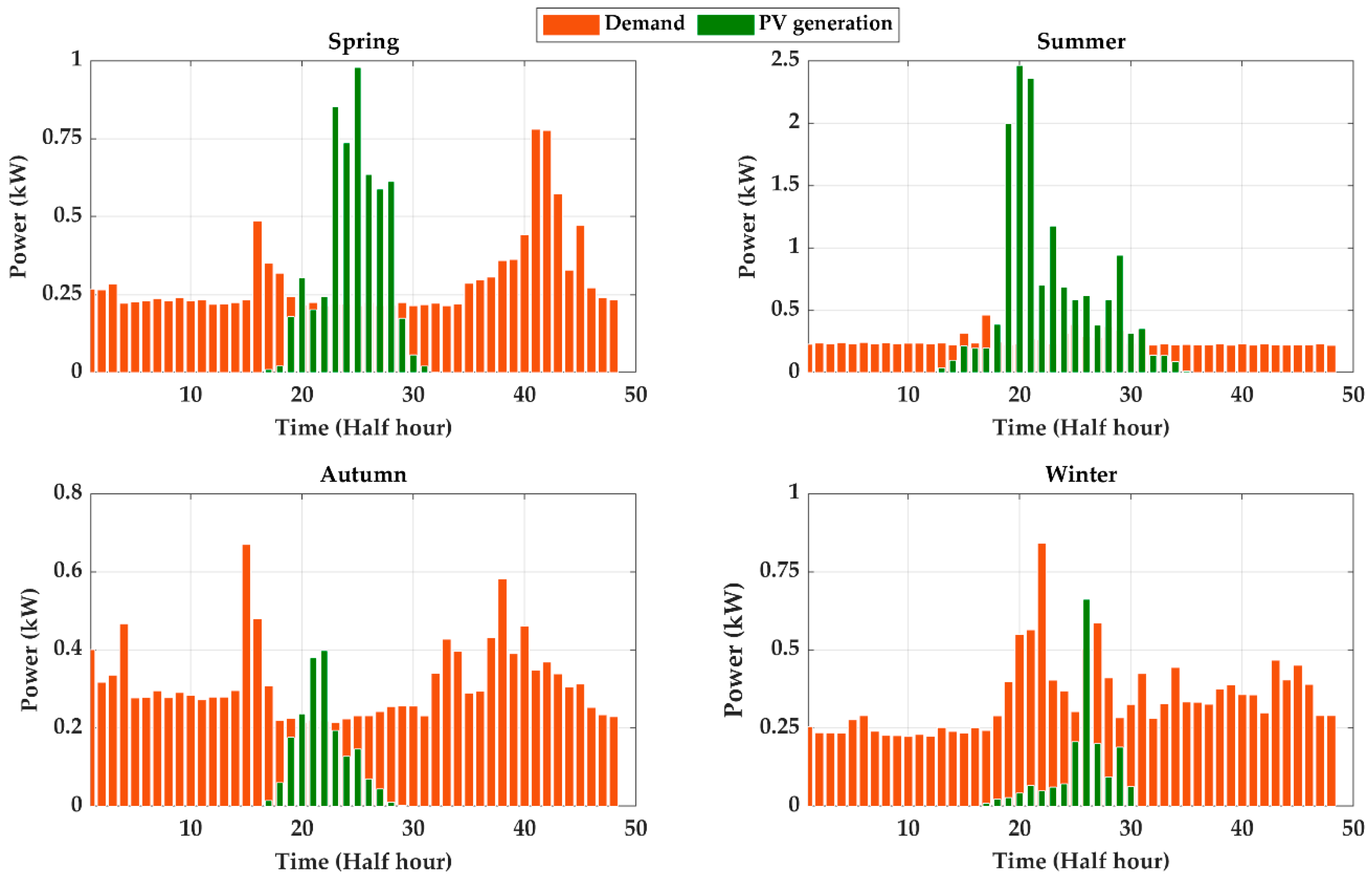
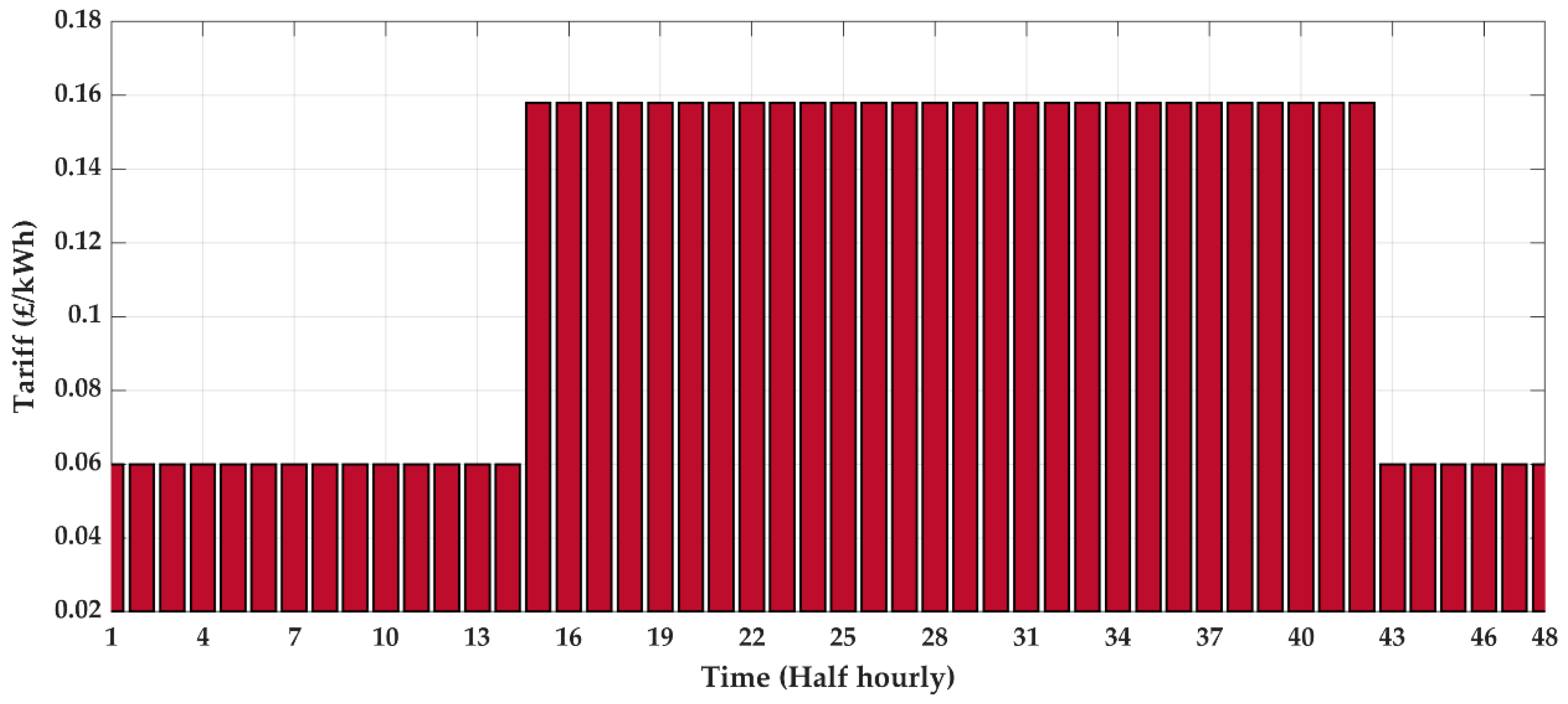
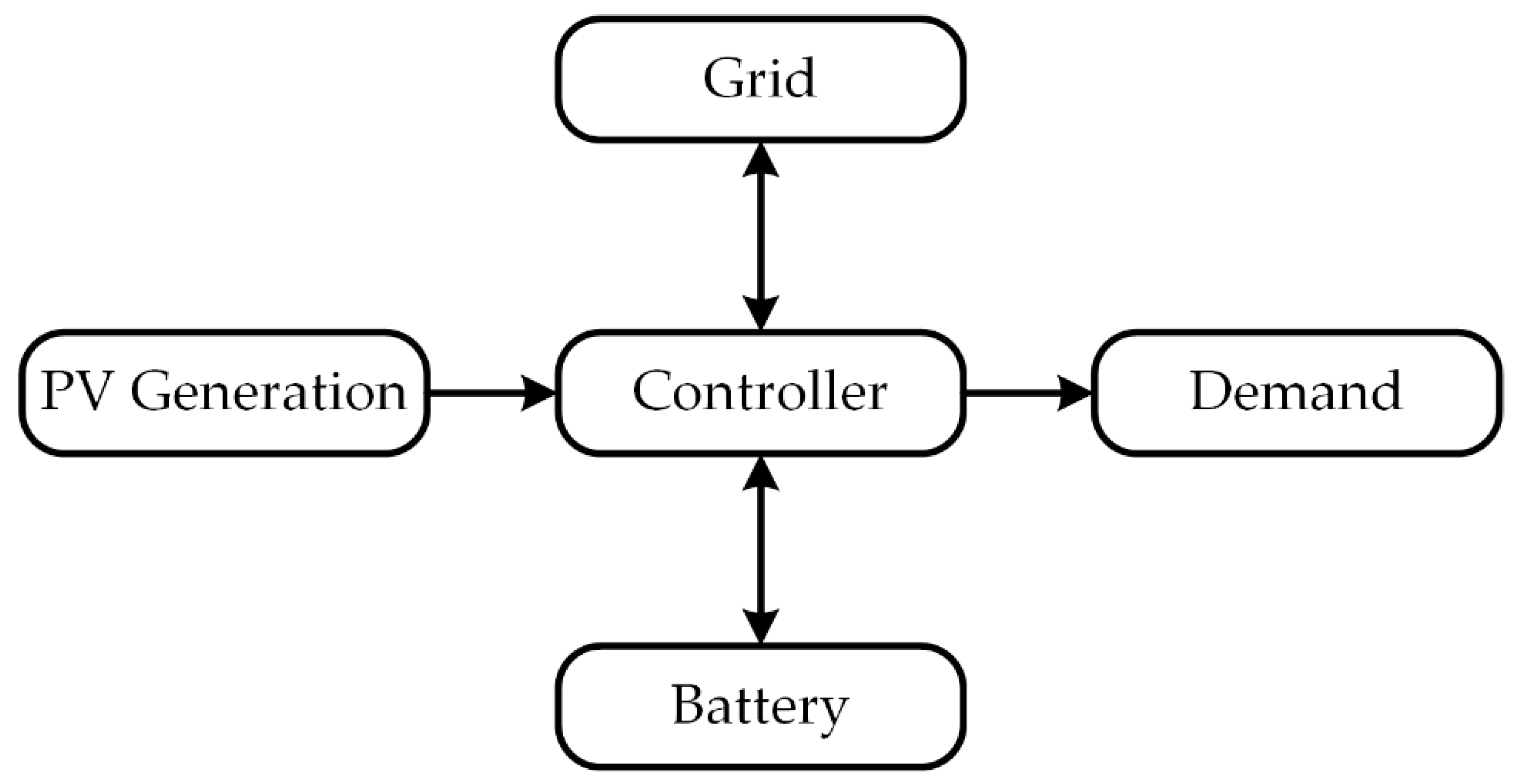
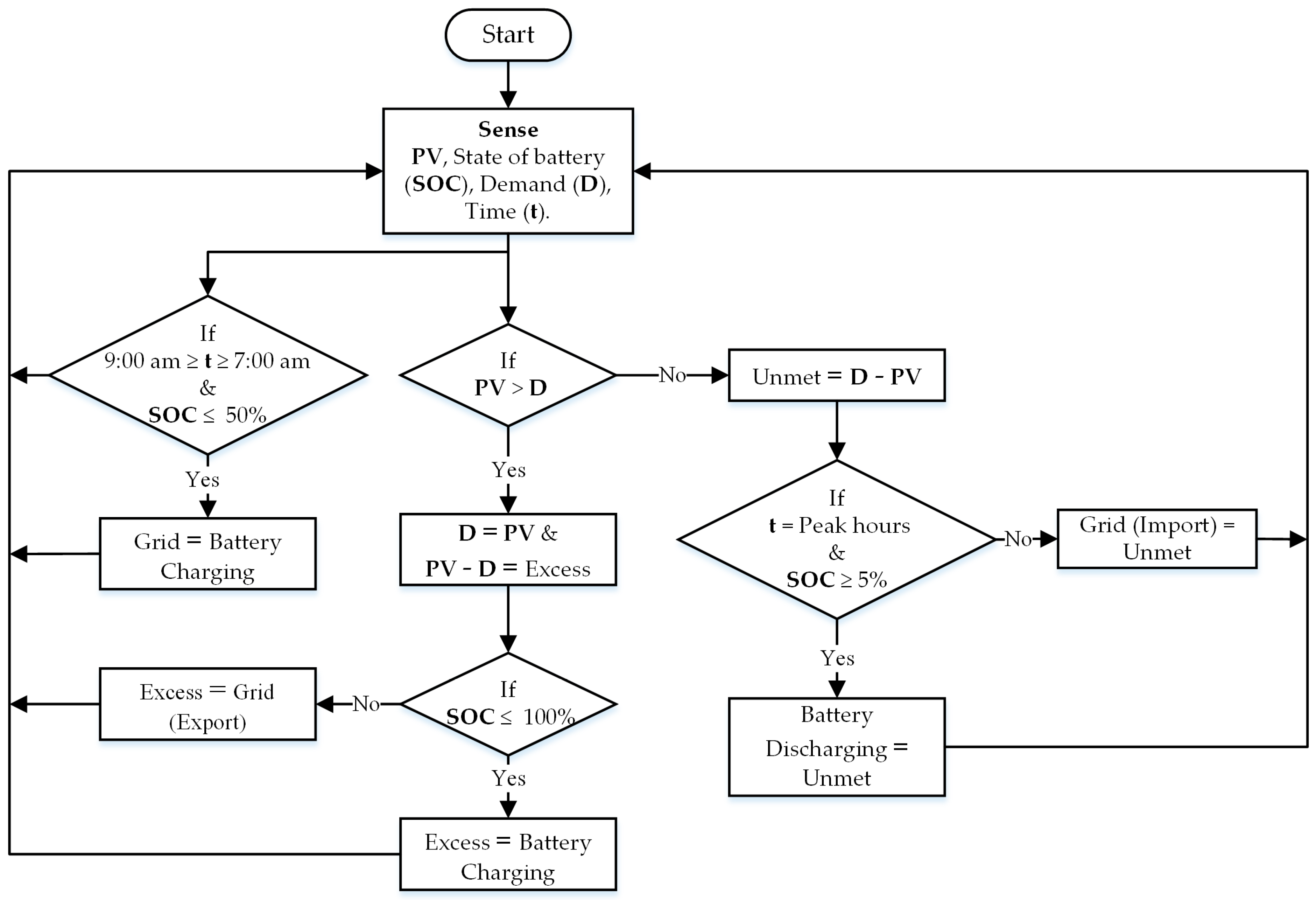

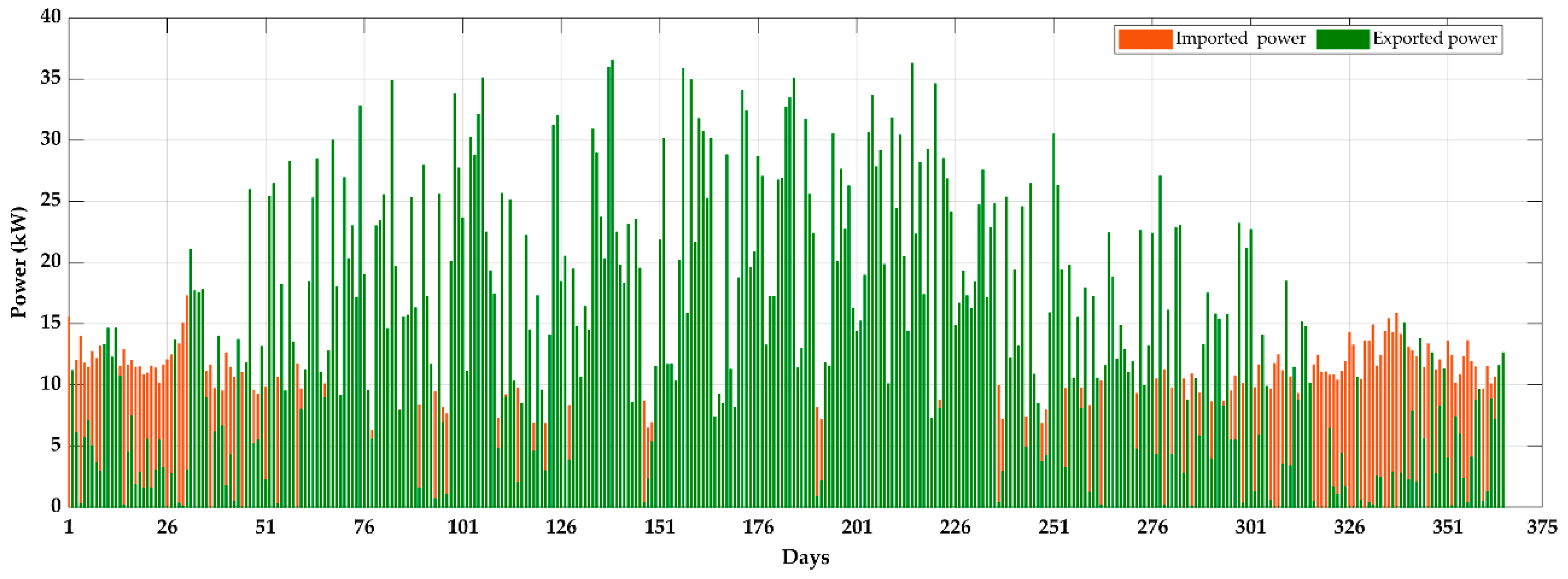



| Case | Battery Capacity (kWh) | Cost of Importing Electricity (£) (A) | Cost of Exporting Electricity (£) (B) | Net Value (£) (C = A − B) |
|---|---|---|---|---|
| 1 | 0 | 288.344 | 0 | 288.344 |
| 2 | 0 | 162.005 | 118.9234 | 43.099 |
| 3 | 2 | 110.8290 | 103.5720 | 7.2570 |
| 3 | 92.2453 | 96.5552 | −4.3129 | |
| 4 | 2 | 100.7748 | 100.00374 | 0.7373 |
| 3 | 85.6395 | 93.6068 | −7.9673 | |
| 5 | 2 | 101.3259 | 108.2678 | −6.9419 |
| 3 | 89.7309 | 106.9980 | −17.2671 |
© 2019 by the authors. Licensee MDPI, Basel, Switzerland. This article is an open access article distributed under the terms and conditions of the Creative Commons Attribution (CC BY) license (http://creativecommons.org/licenses/by/4.0/).
Share and Cite
Hussain Nengroo, S.; Umair Ali, M.; Zafar, A.; Hussain, S.; Murtaza, T.; Junaid Alvi, M.; Raghavendra, K.V.G.; Jee Kim, H. An Optimized Methodology for a Hybrid Photo-Voltaic and Energy Storage System Connected to a Low-Voltage Grid. Electronics 2019, 8, 176. https://doi.org/10.3390/electronics8020176
Hussain Nengroo S, Umair Ali M, Zafar A, Hussain S, Murtaza T, Junaid Alvi M, Raghavendra KVG, Jee Kim H. An Optimized Methodology for a Hybrid Photo-Voltaic and Energy Storage System Connected to a Low-Voltage Grid. Electronics. 2019; 8(2):176. https://doi.org/10.3390/electronics8020176
Chicago/Turabian StyleHussain Nengroo, Sarvar, Muhammad Umair Ali, Amad Zafar, Sadam Hussain, Tahir Murtaza, Muhammad Junaid Alvi, K.V.G. Raghavendra, and Hee Jee Kim. 2019. "An Optimized Methodology for a Hybrid Photo-Voltaic and Energy Storage System Connected to a Low-Voltage Grid" Electronics 8, no. 2: 176. https://doi.org/10.3390/electronics8020176
APA StyleHussain Nengroo, S., Umair Ali, M., Zafar, A., Hussain, S., Murtaza, T., Junaid Alvi, M., Raghavendra, K. V. G., & Jee Kim, H. (2019). An Optimized Methodology for a Hybrid Photo-Voltaic and Energy Storage System Connected to a Low-Voltage Grid. Electronics, 8(2), 176. https://doi.org/10.3390/electronics8020176









